If you use Excel not only to calculate numbers, but also maintain records such as zip codes, security numbers or employee ids, you may need to keep leading zeros in cells. However if you try typing a zip code like "00123" in a cell, Excel will immediately truncate it to "123".
The point is that Microsoft Excel treats postal codes, phone numbers and other similar entries as numbers, applies the General or Number format to them, and automatically removes preceding zeroes. Luckily, Excel also provides the means to keep leading zeros in cells, and further on in this tutorial you will find a handful of ways to do it.
How to keep leading zeros in Excel as you type
For starters, let's see how you can put 0 in front of a number in Excel, for example type 01 in a cell. For this, simply change the cell format to Text:- Select the cell(s) where you want to prefix numbers with 0.
- Go to the Home tab > Number group, and select Text in the Number Format box.
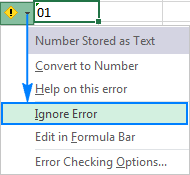
The following screenshot shows the result:
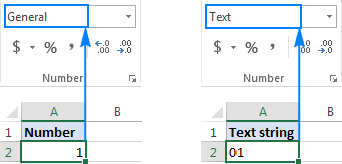
Another way to keep leading zeros in Excel is to prefix a number with an apostrophe ('). For example, instead of typing 01, type '01. In this case, you don't need to change the cell's format.
Bottom line: This simple technique has a significant limitation - the resulting value is a text string, not number, and consequently it cannot be used in calculations and numeric formulas. If that is not what you want, then change only the visual representation of the value by applying a custom number format as demonstrated in the next example.
How to show leading zeroes in Excel using a custom number format
To display leading zeroes, apply a custom number format by performing these steps:- Select a cell(s) where you want to show leading zeros, and press Ctrl+1 to open the Format Cells dialog.
- Under Category, select Custom.
- Type a format code in the Type box. In most cases, you will need a format code consisting of 0 placeholders, like 00. The number of zeros in the format code corresponds to the total number of digits you want to show in a cell (you will find a few examples below).
- Click OK to save the changes.
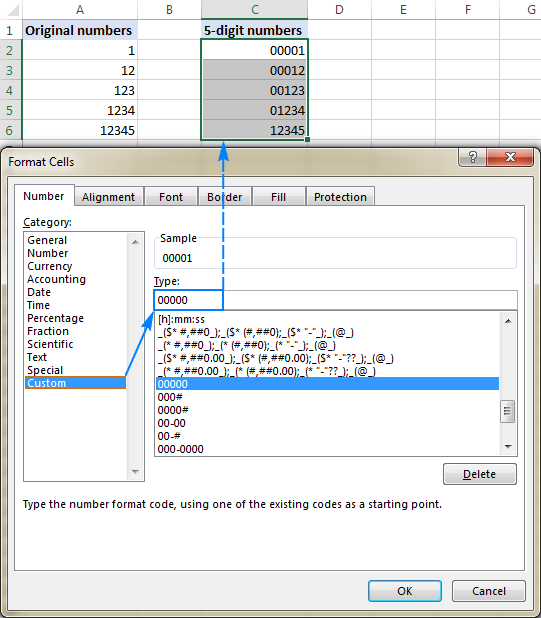
By using Excel custom numbers formats, you can add leading zeros to create fixed-length numbers, like in the above example, and variable-length numbers. It all boils down to which placeholder you use in the format code:
- 0 - displays extra zeros
- # - does not display extra zeros
Your custom number formats can also include spaces, hyphens, parentheses, etc. The detailed explanation can be found here: Custom Excel number format.
The following spreadsheet gives a few more examples of custom formats that can show leading zeros in Excel.
| A | B | C | |
|---|---|---|---|
| 1 | Custom format | Typed number | Displayed number |
| 2 | 00000 | 123 | 00123 |
| 3 | 000# | 123 | 0123 |
| 4 | 00-00 | 1 | 00-01 |
| 5 | 00-# | 1 | 00-1 |
| 6 | 000-0000 | 123456 | 012-3456 |
| 7 | ###-#### | 123456 | 12-3456 |
| A | B | C | D | |
|---|---|---|---|---|
| 1 | Custom format | Typed number | Displayed number | |
| 2 | Zip code | 00000 | 1234 | 01234 |
| 3 | Social security | 000-00-0000 | 12345678 | 012-34-5678 |
| 4 | Credit card | 0000-0000-0000-0000 | 12345556789123 | 0012-3455-5678-9123 |
| 5 | Phone numbers | 00-0-000-000-0000 | 12345556789 | 00-1-234-555-6789 |
Tip. Excel has a few predefined Special formats for postal codes, telephone numbers and social security numbers, as shown in the screenshot below:
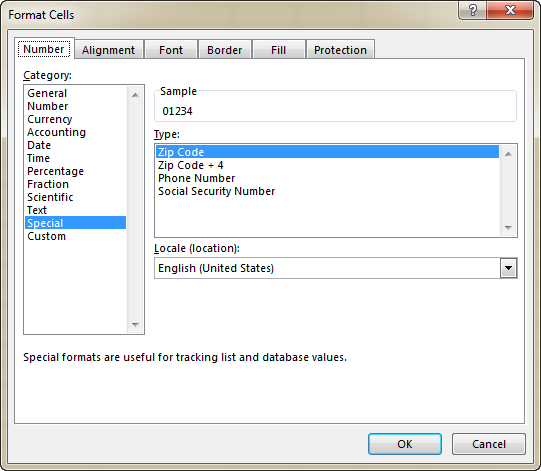
Bottom line: This method is best to be used in situations when you work with a numeric dataset and the results should be numbers,
not text. It changes only the display of a number, but not the number
itself: leading zeros show up in cells, the actual value displays in the
formula bar. When you reference such cells in formulas, the
calculations are perfumed with the original values. Custom formats can
only be applied to numeric data (numbers and dates) and the result is
also a number or date.
How to add leading zeros in Excel with the TEXT function
While a custom number format shows zero in front of a number without actually changing the underlying value, the Excel TEXT function pads numbers with zeros by "physically" inserting leading zeros in cells.To add leading zeros with a TEXT(value, format_text) formula, you use the same format codes as in custom number formats. However, the result of the TEXT function is always a text string, even if it looks much like a number.
For example, to insert 0 before a value in cell A2, use this formula:
=TEXT(A2, "0#")To create a zero-prefixed string of a fixed length, say a 5-character string, use this one:
=TEXT(A2, "000000")Please pay attention that the TEXT function requires enclosing the format codes in quotation marks. And this is how the results will look like in Excel:
| A | B | C | |
|---|---|---|---|
| 1 | Original number | Padded number | Formula |
| 2 | 1 | 01 | =TEXT(B2, "0#") |
| 3 | 12 | 12 | =TEXT(B3, "0#") |
| 4 | 1 | 00001 | =TEXT(B4,"00000") |
| 5 | 12 | 00012 | =TEXT(B5,"00000") |
Bottom line: The Excel TEXT function always returns a text string, not number, and therefore you won't be able to use the results in arithmetic calculations and other formulas, unless you need to compare the output with other text strings.
How to add leading zeros to text strings
In the previous examples, you learned how to add zero before a number in Excel. But what if you need to put zero(s) in front of a text string like 0A102? In that case, neither TEXT nor custom format will work because they deal with numeric values only.If the value to be padded with zero contains letters or other text characters, use one of the following formulas, which offer a universal solution applicable to both numbers and text strings.
Formula 1. Add leading zeros using the RIGHT function
The easiest way to put leading zeros before text strings in Excel is using the RIGHT function:
RIGHT("0000" & cell, string_length)
Where:- "0000" is the maximum number of zeros you want to add. For example, to add 2 zeros, you type "00".
- Cell is a reference to the cell containing the original value.
- String_length is how many characters the resulting string should contain.
=RIGHT("000000"&A2, 6)What the formula does is add 6 zeros to the value in A2 ("000000"&A2), and then extract the right 6 characters. As the result, it inserts just the right number of zeros to reach the specified total string limit:
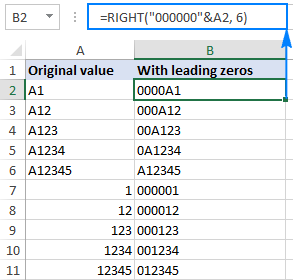
In the above example, the maximum number of zeros equals the total string length (6 characters), and therefore all of the resulting strings are 6-character long (fixed length). If applied to a blank cell, the formula would return a string consisting of 6 zeros.
Depending on your business logic, you can supply different numbers of zeros and total characters, for example:
=RIGHT("00"&A2, 6)As the result, you will get variable-length strings that contain up to 2 leading zeros:
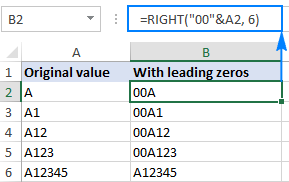
Formula 2. Pad leading zeros using the REPT and LEN functions
Another way to insert leading zeros before a text string in Excel is using this combination of REPT and LEN functions:
REPT(0, number of zeros-LEN(cell))&cell
For example, to add leading zeroes to the value in A2 to create a 6-character string, this formula goes as follows:=REPT(0, 6-LEN(A2))&A2How this formula works:
Knowing that the REPT function repeats a given character a specified number of times, and LEN returns the total length of the string, the formula's logic is easy to understand:- LEN(A2) gets the total number of characters in cell A2.
- REPT(0, 6-LEN(A2)) adds the required number of zeros. To calculate how many zeros should be added, you subtract the length of the string in A2 from the maximum number of zeros.
- Finally, you concatenate zeros with the A2 value, and get the following result:
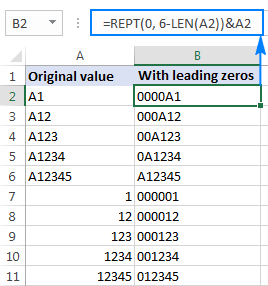
Bottom line: This formula can add leading zeros both to numbers and text strings, but the result is always text, not number.
How to add a fixed number of preceding zeros
To prefix all values in a column (numbers or text strings) with a certain number of zeros, use either the CONCATENATE function or the ampersand operator.For example, to put 0 before a number in cell A2, use one of these formulas:
=CONCATENATE(0,A2)or
=0&A2As shown in the screenshot below, the formula adds just one leading zero to all cells in a column regardless of how many characters the original value contains:
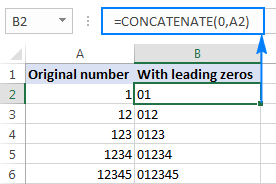
In the same manner, you can insert 2 leading zeros (00), 3 zeros (000) or as many zeros as you want before numbers and text strings.
Bottom line: The result of this formula is also a text string even when you are concatenating zeros with numbers.
How to remove leading zeros in Excel
The method you use to remove leading zeros in Excel depends on how those zeros were added:- If preceding zeroes were added with a custom number format (zeros are visible in a cell, but not in the formula bar), apply another custom format or revert back General as shown here.
- If zeros were typed or otherwise entered in cells formatted as Text (a small green triangle is displayed in the top-left corner of the cell), convert text to number.
- If leading zeroes were added by using a formula (the formula appears in the formula bar when the cell is selected), use the VALUE function to remove them.

Remove leading zeros by changing the cell format
If leading zeroes are shown in cells with a custom format, then change the cell format back to default General, or apply another number format that does not display preceding zeros.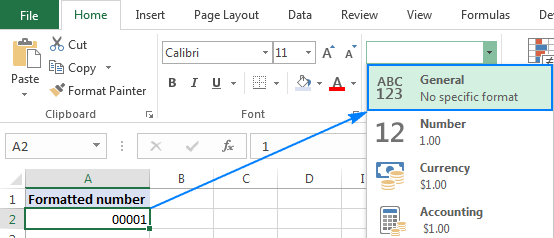
Remove leading zeros by converting text to number
When prefixed zeros appear in a Text-formatted cell, the easiest way to remove them is select the cell(s), click the exclamation point, and then click Convert to Number: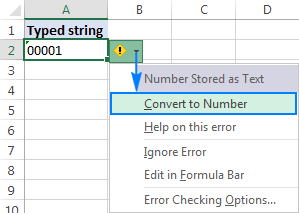
Remove leading zeros by using a formula
In case a preceding zero(s) is added with a formula, use another formula to remove it. The zero-removing formula is as simple as:=VALUE(A2)Where A2 is the cell from which you want to remove preceding zeros.
This method can also be used to get rid of zeros typed directly in cells (like in the previous example) or imported to Excel from some external source. Overall, if you are dealing with a zero-prefixed string that represents a number, you can use the VALUE function to convert text to number and remove leading zeros along the way.
The following screenshot shows two formulas:
- The Text formula in B2 adds zeros to the value in A2, and
- The Value formula in C2 removes the leading zeros from the value in B2.

How to hide zeros in Excel
If you don't want to display zero values in your Excel sheet, you have the following two options:- To hide zeros across the entire sheet, uncheck the Show a zero in cells that have zero value option. For this, click File > Options > Advanced, and scroll down to the Display options for this worksheet section:

- To hide zero values in certain cells, apply the following custom number format to those cells: #;#;;@
The screenshot below shows that cell B2 does contain a zero value, but it is not displayed in the cell:
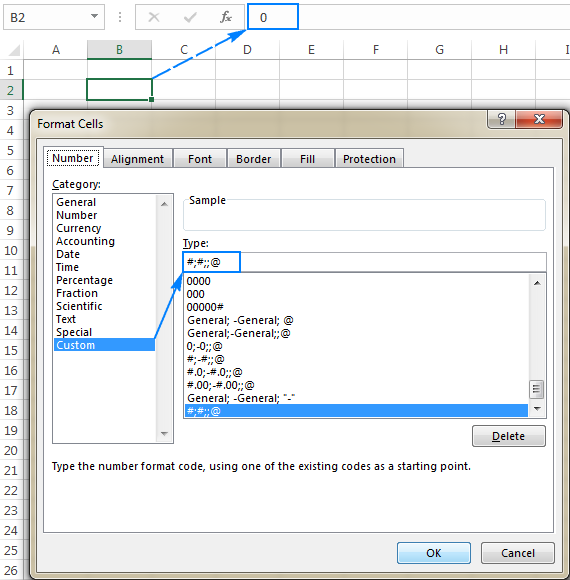
This is how you can add, remove and hide zeros in Excel. To better understand the techniques described in this tutorial, you are welcome to download the sample Excel Leading Zeros Workbook. I thank you for reading and hope to see you on our blog next week.



0 Comments: